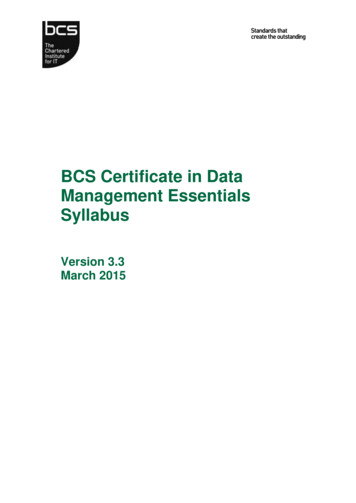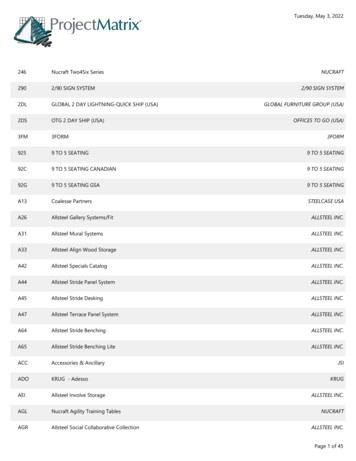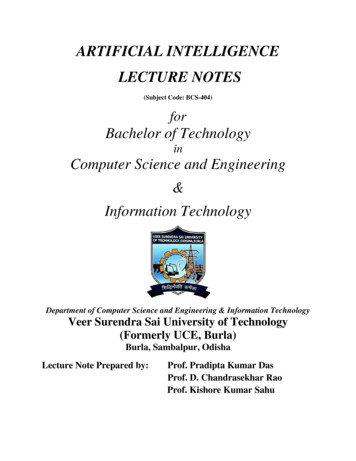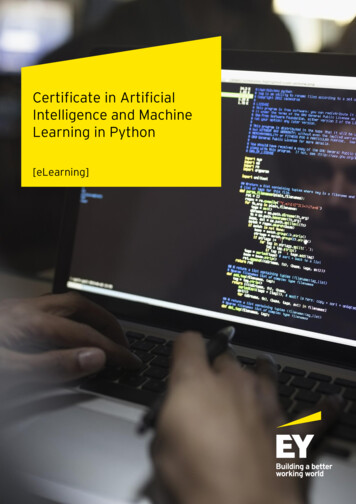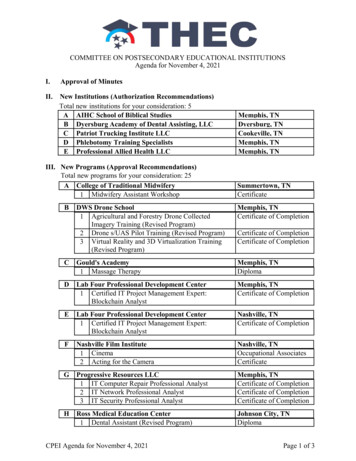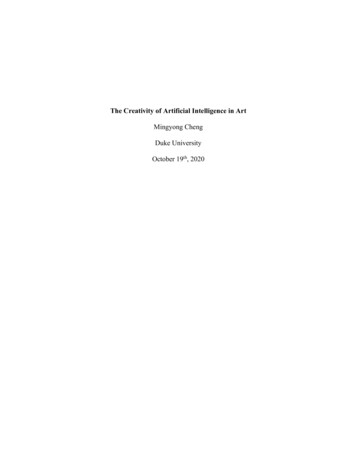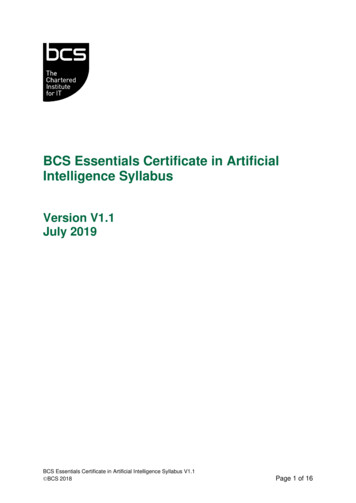
Transcription
BCS Essentials Certificate in ArtificialIntelligence SyllabusVersion V1.1July 2019BCS Essentials Certificate in Artificial Intelligence Syllabus V1.1 BCS 2018Page 1 of 16
Change HistoryThis log provides a single point of reference, where a summary of any changes is recorded,to include the date of the amendment and a summary of the changes made.VersionNumberVersion 1.1July 2019Version 1.0February 2019Version 0.6January 2019Changes MadeCorrection to Trainer CriteriaSigned off; made liveReading list updatedVersion 0.5December 2018Added additional LOs: 2.4, 2.5, 3.3, 3.4, 3.5Version 0.4October 2018BCS Formatted syllabus created.BCS Essentials Certificate in Artificial Intelligence Syllabus V1.1 BCS 2018Page 2 of 16
ContentsChange History . 2Introduction . 4Levels of Knowledge / SFIA Levels . 4Learning Outcomes . 4Target Audience. 5Course Format and Duration . 5Examination Format and Duration . 6Eligibility for the Examination . 6Additional Time . 6Guidelines for Accredited Training Organisations . 7Exam Weighting .7Syllabus . 8Learning Objectives . 81 Artificial and Human Intelligence: an Introduction and History (25%) . 82 Examples of AI: Benefits, Challenges and Risks (30%). 83 An introduction to Machine Learning (35%). 84 The Future of Artificial Intelligence – Human and Machine Together (10%) . 9Recommended Reading List . 10Abbreviations . 12Glossary of Terms . 12BCS Essentials Certificate in Artificial Intelligence Syllabus V1.1 BCS 2018Page 3 of 16
IntroductionArtificial Intelligence (AI) is a methodology for using a non-human system to learn fromexperience and imitate human intelligent behaviour. The BCS Essentials Certificate in ArtificialIntelligence tests a candidate’s knowledge and understanding of the terminology and thegeneral principles. This syllabus covers the potential benefits; types of Artificial Intelligence;the basic process of Machine Learning (ML); the challenges and risks associated with an AIproject, and the future of AI and Humans in work.Levels of Knowledge / SFIA LevelsThis syllabus will provide candidates with the levels of difficulty highlighted within the followingtable, also enabling them to develop the skills to operate at the highlighted level ofresponsibility (as defined within the SFIA framework) within their workplace. The levels ofknowledge and SFIA levels are further explained on the website.Level7654321Levels of KnowledgeLevels of Skill and Responsibility mberSet strategy, inspire and mobiliseInitiate and influenceEnsure and adviseEnableApplyAssistFollowLearning OutcomesCandidates should be able to demonstrate a basic knowledge and understanding of generalconcepts in the following areas:1. Human and Artificial Intelligence;2. The Machine Learning process;3. The benefits, challenges and risks of a Machine Learning project;4. The future of humans and machines in Work.BCS Essentials Certificate in Artificial Intelligence Syllabus V1.1 BCS 2018Page 4 of 16
Target AudienceThe Artificial Intelligence Essentials certificate is focussed on individuals with an interest in,(or need to implement) AI in an organisation, especially those working in areas such asscience, engineering, knowledge engineering, finance, or IT services.The following roles could be interested: Engineers Scientists Professional research managers Chief technical officers Chief information officers Organisational change practitioners and managers Business change practitioners and managers Service architects and managers Program and planning managers Service provider portfolio strategists / leads Process architects and managers Business strategists and consultants Web page developersCourse Format and DurationCandidates can choose to study for this certificate from one of two ways: by either attendinga training course provided by a BCS Accredited Training Organisation, or by self-study.BCS recommends that for full coverage of the syllabus to be achieved, training coursesleading to the certificate should normally run for a minimum 6 hours over 1 day.Candidates should spend about 40 hours on self-study with no prior knowledge.BCS Essentials Certificate in Artificial Intelligence Syllabus V1.1 BCS 2018Page 5 of 16
Examination Format and DurationType20 Multiple choice questionsDuration30 MinutesSupervisedYesOpen BookNoPass Mark13/20Calculators No calculators nor mobile technology is permittedDeliveryPaper based examinationEligibility for the ExaminationThere are no specific pre-requisites for the entry to the examination, although a goodknowledge of computers and a basic understanding of data using computers (e.g.spreadsheets) is highly recommended.Additional TimeFor Candidates Requiring Reasonable Adjustments Due to a DisabilityPlease refer to the reasonable adjustments policy for information on how and when to apply.For Candidates Whose Language is Not the Language of the ExaminationIf the examination is taken in a language that is not the candidate’s native/official language,then they are entitled to: 25% extra time.Use their own paper language dictionary (whose purpose is translation between theexamination language and another national language) during the examination.Electronic versions of dictionaries will not be allowed into the examination room.BCS Essentials Certificate in Artificial Intelligence Syllabus V1.1 BCS 2018Page 6 of 16
Guidelines for Accredited Training OrganisationsEach major subject heading in this syllabus is assigned an allocated percentage of study time.The purpose of this is:1) Guidance on the proportion of time allocated to each section of an accredited course.2) Guidance on the proportion of questions in the exam.Courses do not have to follow the same order as the syllabus and additional exercises maybe included, if they add value to the training course.Exam WeightingSyllabus AreaTarget Number of QuestionsArtificial and Human Intelligence: AnIntroduction and History25% - 5 Questions – K1Examples of AI - Benefits, Challenges andRisks30% - 6 Questions – K2An introduction to Machine Learning35% - 7 Questions – K1The Future of Artificial Intelligence – Humanand Machine Together10% - 2 Questions – K1Trainer CriteriaThe following criterion apply: Hold an Essentials Certificate in Artificial Intelligence;Have 3 years’ experience in related subject (including, but not limited to: data science,high performance computing, scientific computing, data analytics, statistics,mathematics);Have taught courses professionally.Classroom SizeTrainers may instruct up to 15 candidates.Invigilator to Candidate Ratio During ExaminationUp to 25 candidates per invigilator.BCS Essentials Certificate in Artificial Intelligence Syllabus V1.1 BCS 2018Page 7 of 16
SyllabusLearning Objectives1.Artificial and Human Intelligence: An Introduction and History (25%)Candidates will be able to:1.1Recall the general definition of human and Artificial Intelligence (AI);1.2Describe ‘learning from experience’ and how it relates to Machine Learning (ML) (TomMitchell’s explicit definition);1.3Understand that ML is a significant contribution to the growth of Artificial Intelligence;1.4Describe how AI is part of ‘Universal Design,’ and ‘The Fourth Industrial Revolution’.2.Examples of AI: Benefits, Challenges and Risks (30%)Candidates will be able to:2.1Explain the benefits of Artificial Intelligence, and2.1.1 list advantages of machine and human and machine systems;2.2Describe the challenges of Artificial Intelligence, and give:2.2.1 general examples of the limitations of AI compared to human systems,2.2.2 general ethical challenges AI raises.2.3Demonstrate understanding of the risks of Artificial Intelligence, and2.3.1 give at least one a general example of the risks of AI;2.4Identify a typical funding source for AI projects;2.5List opportunities for AI.3.An introduction to Machine Learning (35%)3.1Candidates will be able to:Demonstrate understanding of the AI intelligent agent description, and:3.1.1 identify the differences with Machine Learning (ML), and:3.1.2 list the four rational agent dependencies,3.1.3 describe agents in terms of performance measure, environment, actuators andsensors,BCS Essentials Certificate in Artificial Intelligence Syllabus V1.1 BCS 2018Page 8 of 16
3.1.4 describe four types of agent: reflex, model-based reflex, goal-based and utilitybased.3.2Give typical examples of Machine Learning in the following contexts:3.2.1 business,3.2.2 social (media, entertainment),3.3.3 science.3.3Recall which typical, narrow AI capability is useful in ML and AI agents’ functionality;3.4Describe and give examples of the following forms of ML:3.4.1 supervised,3.4.2 unsupervised,3.4.3 reinforcement.3.5 Describe the basic schematic of a neutral network.4.The Future of Artificial Intelligence – Human and Machine Together (10%)Candidates will be able to:4.1Demonstrate an understanding that Artificial Intelligence (in particular, MachineLearning) will drive humans and machines to work together;4.2List future directions of humans and machines working together.BCS Essentials Certificate in Artificial Intelligence Syllabus V1.1 BCS 2018Page 9 of 16
Recommended Reading ListArtificial Intelligence and ConsciousnessTitle Artificial Intelligence, A Modern Approach, 3rd EditionAuthor Stuart Russell and Peter Norvig,Publication Date2016,ISBN 10 1292153962Title The Cambridge Handbook of Artificial Intelligence,Author Keith Frankish and William RamseyPublication Date 2014ISBN 978-0-521-69191-8Title The Conscious MindAuthor David ChalmersPublication Date 1996ISBN 978-0-19-511789-9Title Life 3.0Author Max TegmarkPublisher Penguin BooksPublication Date 2017ISBN 978-0-141-98180-2Machine LearningTitle Machine LearningAuthor Tom Mitchell,Publisher McGraw-HillPublication Date 1997,ISBN 0071154671.Title Machine Learning For Absolute Beginners: A Plain English Introduction (2nd Edition),Author Oliver Theobald,Publication Date 2017ISBN 1549617214.High Level / Management Consultant View of Machine LearningTitle The Fourth Industrial RevolutionAuthor Klaus SchwabPublisher Penguin Random HousePublication Date 2016ISBN 978-0-241-30075-6BCS Essentials Certificate in Artificial Intelligence Syllabus V1.1 BCS 2018Page 10 of 16
Title Human Machine - Reimagining Work in the Age of AIAuthor Paul R. Daugherty and H. James WilsonPublisher Harvard Business Review PressPublication Date 2018ISBN 1633693869.High Level / Research and Political View of Machine jects/machine-learning/Professional Development of Machine Learning Algorithms and PlanningTitle Hands-On Machine Learning with -Learn and TensorFlow: Concepts, Tools, andTechniques to Build Intelligent SystemsAuthor Aurélien GéronPublisher O’ReillyPublication Date 2017ISBN 1491962291.Title Machine Learning – A Probabilistic PerspectiveAuthor Kevin P. MurphyPublisher MITPublication Date 2012ISBN-10 0262018020Additional Reading:Title The Singularity is NearAuthor Ray KurzweilPublisher Duckworth OverlookPublication Date 2005ISBN 978-0715635612Title The Mythical Man MonthAuthor Frederick P. Brooks, JR.,Publisher Addison WesleyPublication Date 1995ISBN 0-201-83595-9Title Artificial Intelligence: 101 Things You Must Know Today About Our FutureAuthor Lasse RouhiainenPublisher CreateSpace Independent Publishing PlatformPublication Date 2018ISBN 1982048808.BCS Essentials Certificate in Artificial Intelligence Syllabus V1.1 BCS 2018Page 11 of 16
NAGICPUGPURPACARTITIQEQMeaningArtificial IntelligenceInternet of ThingsArtificial Neural NetworkNeural NetworkConvolution Neural NetworkMachine LearningOptical Character RecognitionNatural Language ProcessingDeep LearningDeep Neural NetworksArtificial General IntelligentCentral Processing UnitGraphical Processing UnitRobotic Process AutomationClassification and Regression TreesInformation TechnologyIntelligence QuotientEmotional QuotientGlossary of TermsTermActivation FunctionAgent ModellingDescription or DefinitionThe activation function defines the output of a node given an inputor set of inputs.An intelligent agent (IA) is autonomous, observes through sensorsand acts on its environment using actuators.AlgorithmAn algorithm is an unambiguous specification of how to solve aclass of problems.Artificial Intelligence(AI)A branch of computer science dealing with the simulation ofintelligent behaviour in computers.AutomationAutomatically controlled operation of an apparatus, process, orsystem by mechanical or electronic devices that take the place ofhuman labour.Undertaken or carried on without outside controlAn axon is a long, slender projection of a nerve cell, or neuron,that typically conducts electrical impulses.AutonomousAxonAxon TerminalsAxon terminals are terminations of the telodendria (branches) ofan axon.Back-propagationA method used in artificial neural networks to calculatea gradient required in the calculation of the weights to be used inthe network.A Bayesian network or belief network is a probabilistic graphicalmodel that represents a set of variables and their conditionaldependencies.Deviation of the expected value of a statistical estimate from thequantity it estimates.Bayesian NetworkBiasBCS Essentials Certificate in Artificial Intelligence Syllabus V1.1 BCS 2018Page 12 of 16
TermBig DataBoostingBootstrap Aggregating –BaggingChatbotClassificationClusteringCognitive SimulationCombinatorial ComplexityCombinatorial ExplosionConnectionistData AnalyticsData CleaningData MiningData ScienceData ScrubbingDecisions TreesDeep LearningDendritesEdgesEmotional Intelligence orEmotional Quotient (EQ)EnsembleExpert SystemsFeedforward Neural NetworkFunctionalityGenetic AlgorithmsDescription or DefinitionBig data is data sets that are so big and complex thattraditional data-processing application software are inadequate todeal with them.Boosting is an ensemble meta-algorithm for reducing bias, andalso variance in supervised learning and family algorithms thatconvert weak learners to strong ones.Bootstrap aggregating, is an ensemble meta-algorithm usedin statistical classification and regression.A chatbot is an artificial intelligence program that conductsa conversation via auditory or textual methods.Classification is the problem of identifying to which of a setof classes a new observation belongs.Clustering groups a set of objects in such a way that objects in thesame group are more similar to each other than to those in othergroups.Cognitive simulation uses computers that test how the humanmind works.Is the exponential growth in computer power required to solve aproblem that has many combinations with increasing complexity.A combinatorial explosion is the rapid growth of the complexity ofa problem due to the combinations of the problem’s inputparameters.Cognitive science that hopes to explain intellectual abilities usingartificial neural networks.The discovery, interpretation, and communication of meaningfulpatterns in data.Data cleaning detects and corrects( or removes ) corrupt or inaccurate records from a recordset, table, or database and refers to identifying incomplete,incorrect, inaccurate or irrelevant parts of the data and thenreplacing, modifying, or deleting the dirty or coarse data.The process of discovering patterns in large data sets.Data science uses scientific methods, processes, algorithms andsystems to understand data.See data cleaning.A decision tree is a decision support tool that uses a treelike graph or model of decisions and their possible consequences.Deep learning is a class of algorithms that use a cascade ofmultiple layers for feature extraction and transformation. Eachsuccessive layer uses the output from the previous layer as input.Dendrites are branched extensions of a nerve cell that propagatethe electrochemical stimulation.Edges are the machine learning name for the brain’s axonsThe understanding of our emotions and the emotions of others.Ensemble methods use multiple learning algorithms to obtainbetter predictive performance than could be obtained from any ofthe constituent learning algorithms alone.An expert system is a computer system that emulates thedecision-making ability of a human expert.A feedforward neural network is an artificial neuralnetwork wherein connections between the nodes do not form acycle.The tasks that a computer software program can doa genetic algorithm (GA) is an algorithm inspired by the processof natural selection.BCS Essentials Certificate in Artificial Intelligence Syllabus V1.1 BCS 2018Page 13 of 16
TermHardwareHeuristicHigh Performance Computing– Super ComputingHyper-parametersInductive ReasoningInternet of Things (IoT)Intelligent Quotient (IQ)k-Meansk-Nearest NeighboursLayersLinear AlgebraLogistic RegressionMachine Learning(ML)Model OptimisationNatural Language Processing(NLP)Natural LanguageUnderstanding(NLU)Nearest Neighbour AlgorithmNeural Network(NN)NodesOne-hot EncodingOntologyOptical Character Recognition(OCR)Over-fitting or Over-trainingProbabilistic InferenceDescription or DefinitionHardware are the physical parts or components of a computer.Heuristic is a strategy derived from previous experiences withsimilar problems.HPC or Supercomputing is a computer with a high level ofperformance compared to a general-purpose computer.A hyperparameter is a parameter whose value is set before thelearning process begins.Inductive reasoning makes broad generalisations from specificobservations.The Internet of Things (IoT) is the network of physical devices,vehicles, home appliances, and other items embeddedwith electronics, software, sensors, actuators,and connectivity which enables these things to connect andexchange data.Is a standard test of intelligence.k-Means is a clustering algorithm that partitions observationsinto k clusters, where each observation belongs to the cluster withthe nearest mean, serving as a prototype of the cluster.The simplest clustering algorithm used to classify new data pointsbased on the relationship to nearby data points.Neural networks are organised into layers and a layer is a set ofinterconnected nodes.Linear algebra is the branch of mathematics concerning linearequations and functions and their representationsthrough matrices and vector spaces.Logistic Regression is used in binary classification to predict twodiscrete classes.Machine learning is a subset of artificial intelligence in the field ofcomputer science that gives computers the ability to learn fromdata.The improvement of the output of a machine learning algorithm(e.g. adjusting hyper parameters).Natural Language Processing (NLP) is an area of artificialintelligence concerned with the interactions between computersand human (natural) languages, and how these happen.Natural Language Understanding is the term used to describemachine reading comprehension.The Nearest Neighbour Algorithm was one of thefirst algorithms used to determine a solution to the travellingsalesman problem.A Machine Learning Algorithm that is based on a mathematicalmodel of the biological brain.Nodes represent neurons (biological brain) and areinterconnected to form a neural network.Transforms text-based features into a numerical form, e.g. false isgiven the number zero and true is given the number 1.Ontology is the philosophical study of the natureof being, becoming, existence, or reality, as well as thebasic categories of being and their relations.Optical Character Recognition is the conversion of images oftyped, handwritten or printed text into machine-encoded text.Overfitting is a machine learning model that is too complex, hashigh variance and low bias. It is the opposite of Under-fitting orUnder-training.Probabilistic Inference uses simple statistical data to build nets forsimulation and models.BCS Essentials Certificate in Artificial Intelligence Syllabus V1.1 BCS 2018Page 14 of 16
TermProbabilityPruningPythonRandom Decision ForestsRandom ForestsRegression AnalysisReinforcement MachineLearning (RL)RoboticsRobotic Process Automation(RPA)ScriptingSearchSemi-supervised MachineLearningSigmoid FunctionSoftwareSoftware RobotsStrong AI or Artificial GeneralIntelligenceSupervised Machine LearningSupport Vector MachineSwarm Intelligence (SI)SymbolicSystemThe Fourth IndustrialRevolutionTuring MachineDescription or DefinitionProbability is the measure of the likelihood that an event willoccur.Pruning reduces the size of decision trees.A programming language popular in machine learning.Random Decision Forests are an ensemble learning methodfor classification, regression and other tasks.Random Forests are an ensemble learning methodfor classification, regression and other tasks, that operate byconstructing a multitude of decision trees at training time.In machine learning, regression analysis is a simple, supervisedlearning technique used to find a trendline to describe the data.Reinforcement Learning (RL) uses software agents thattake actions in an environment to maximise some notion ofcumulative reward.Robotics deals with the design, construction, operation, and useof robots, as well as computer systems for their control, sensoryfeedback, and information processing.Robotic Process Automation is a business processautomation technology based on the notion of softwarerobots or artificial intelligence workers.Scripting are programs written for a special run-timeenvironment that automate the execution of tasks that couldalternatively be executed one-by-one by a human operator.The use of machine learning in search problems, e.g. shortestpath.Machine learning that uses labelled and unlabelled data fortraining.A sigmoid function is a mathematical function having acharacteristic "S"-shaped curve or sigmoid curve.Software is a generic term that refers to a collection of data andcomputer instructions that tell the computer how to work.A software robot replaces a function that a human wouldotherwise do.Strong AI's goal is the development of artificial intelligence to thepoint where the machine's intellectual capability is functionallyequal to a human’s.Supervised Machine Learning is the task of learning a functionthat maps an input to an output based on example input-outputpairs.A support vector machine constructs a hyperplane or set ofhyperplanes in a high- or infinite- dimensional space, which canbe used for classification, regression, or other tasks like outlierdetection.Swarm Intelligence is the collectivebehaviour of decentralised, self-organised systems, natural orartificialSymbolic artificial intelligence is the term for the collection of allmethods in artificial intelligence research that are based on highlevel "symbolic" (human-readable) representations ofproblems, logic and search.A regularly interacting or interdependent group of items forming aunified whole.The Fourth Industrial Revolution builds on the Digital Revolution,representing new ways in which technology becomes embeddedwithin societies and even the human body.A Turing machine is a mathematical model of computation.BCS Essentials Certificate in Artificial Intelligence Syllabus V1.1 BCS 2018Page 15 of 16
TermUnsupervised MachineLearningUnderfittingUniversal DesignValidation DataVarianceVisualisationWeak AI or Narrow AIWeightsDescription or DefinitionUnsupervised Machine Learning infers a function that describesthe structure of unlabelled data.Underfitting is when the machine learning model has low varianceand high bias. It is the opposite of Overfitting or Overtraining.Universal Design (close relation to inclusive design) refers tobroad-spectrum ideas meant to produce buildings, products andenvironments that are inherently accessible to older people,people without disabilities, and people with disabilities.A set of data used to test the output of a machine learning modelthat is not used to train the model.Variance is the expectation of the squared deviation of a randomvariable from its mean.Visualisation is any technique for creating images, diagrams,or animations to communicate a message.Weak artificial intelligence (weak AI), also known as NarrowAI, is artificial intelligence that is focused on one narrow task. It isthe contrast of Strong AI.A weight function is a mathematical device used when performinga sum, integral, or average to give some elements more "weight"or influence on the result than other elements in the same set.BCS Essentials Certificate in Artificial Intelligence Syllabus V1.1 BCS 2018Page 16 of 16
BCS Essentials Certificate in Artificial Intelligence Syllabus V1.1 BCS 2018 Page 8 of 16 Syllabus Learning Objectives 1. Artificial and Human Intelligence: An Introduction and History (25%) Candidates will be able to: 1.1 Recall the general definition of human and Artificial Intelligence (AI);


